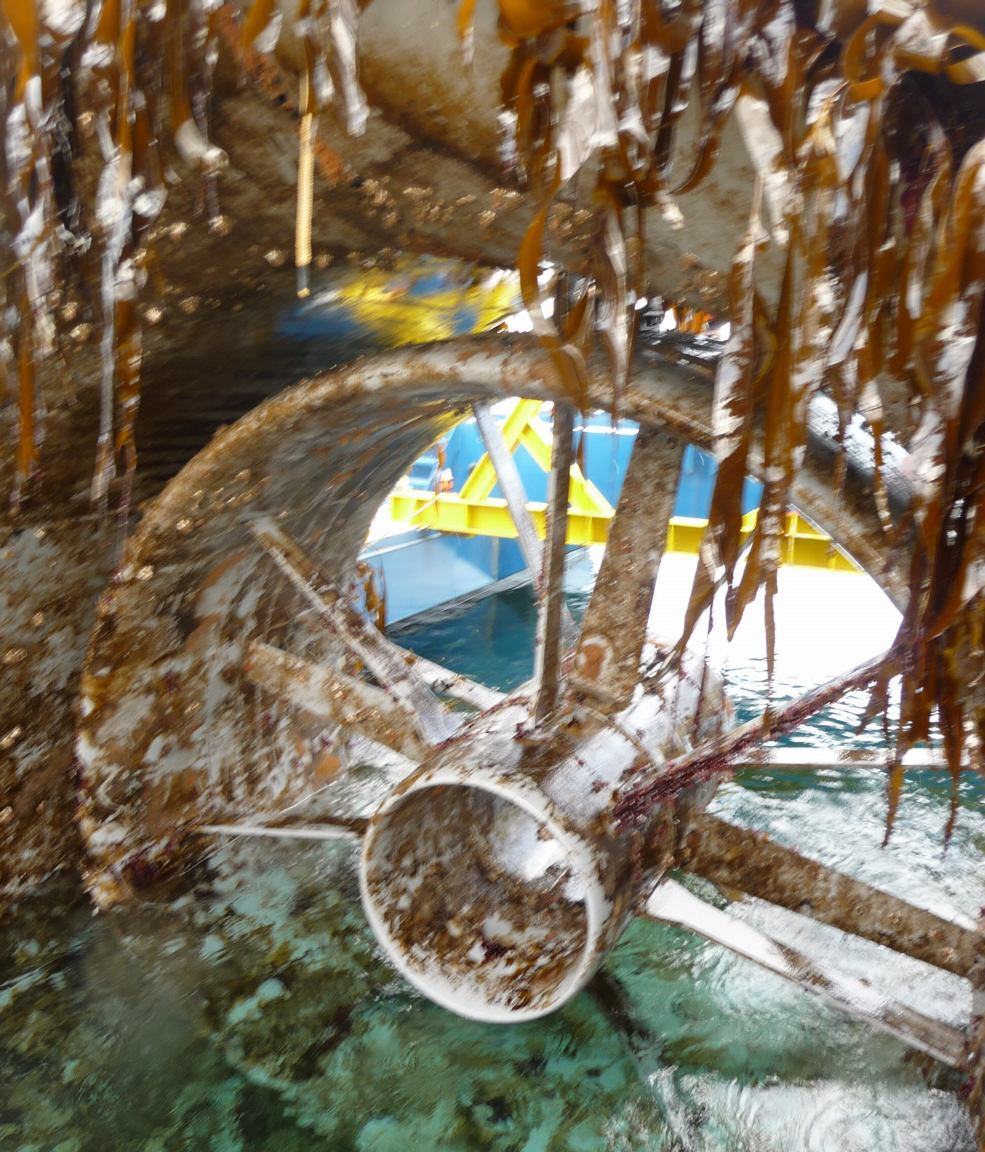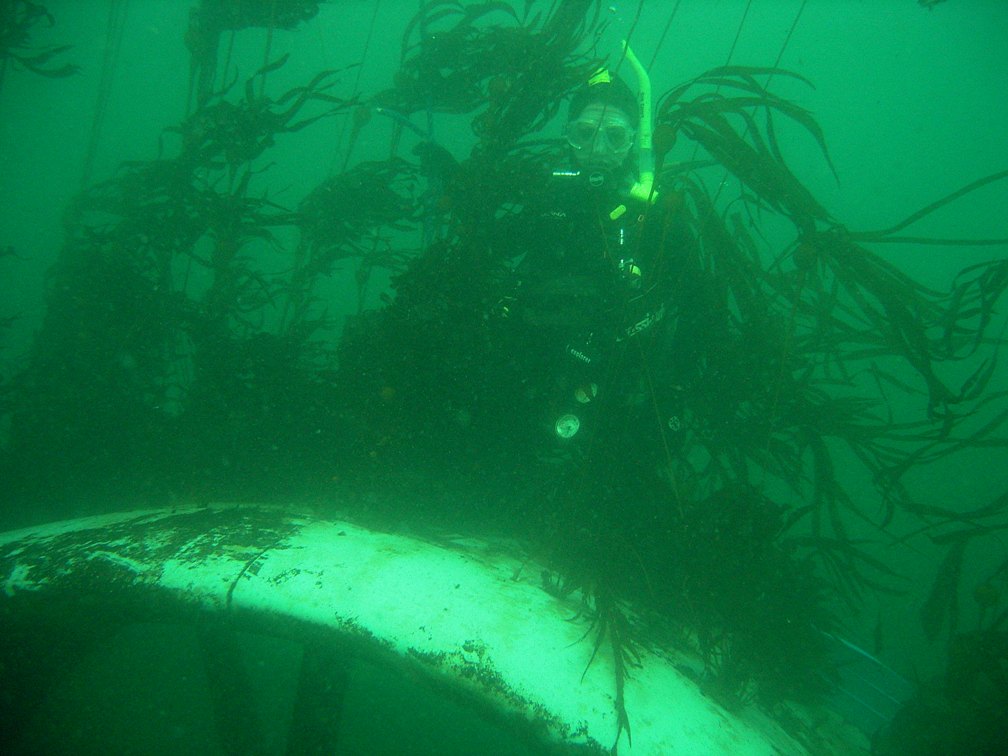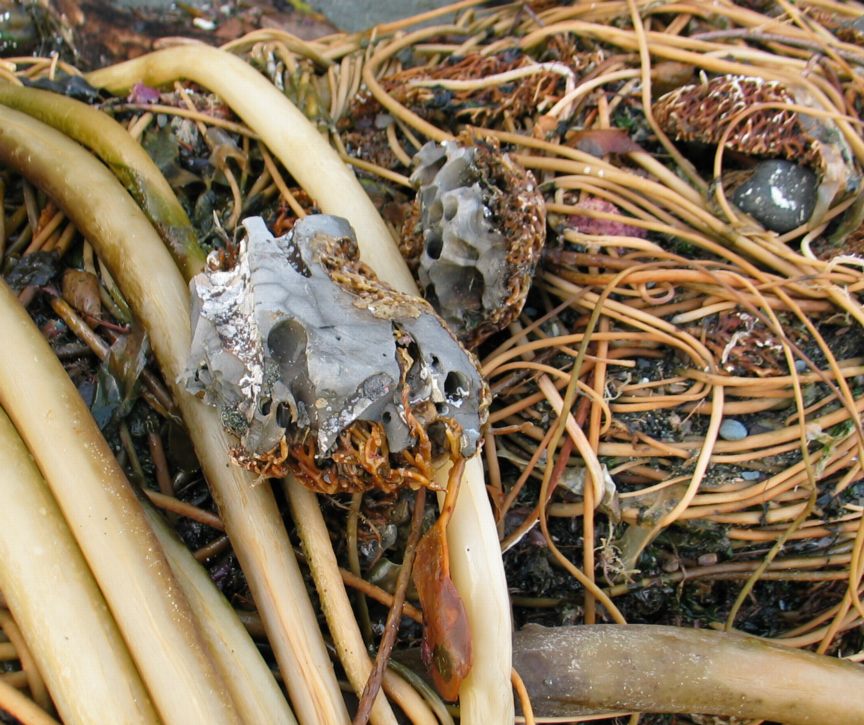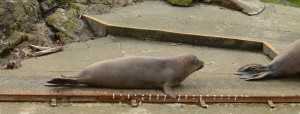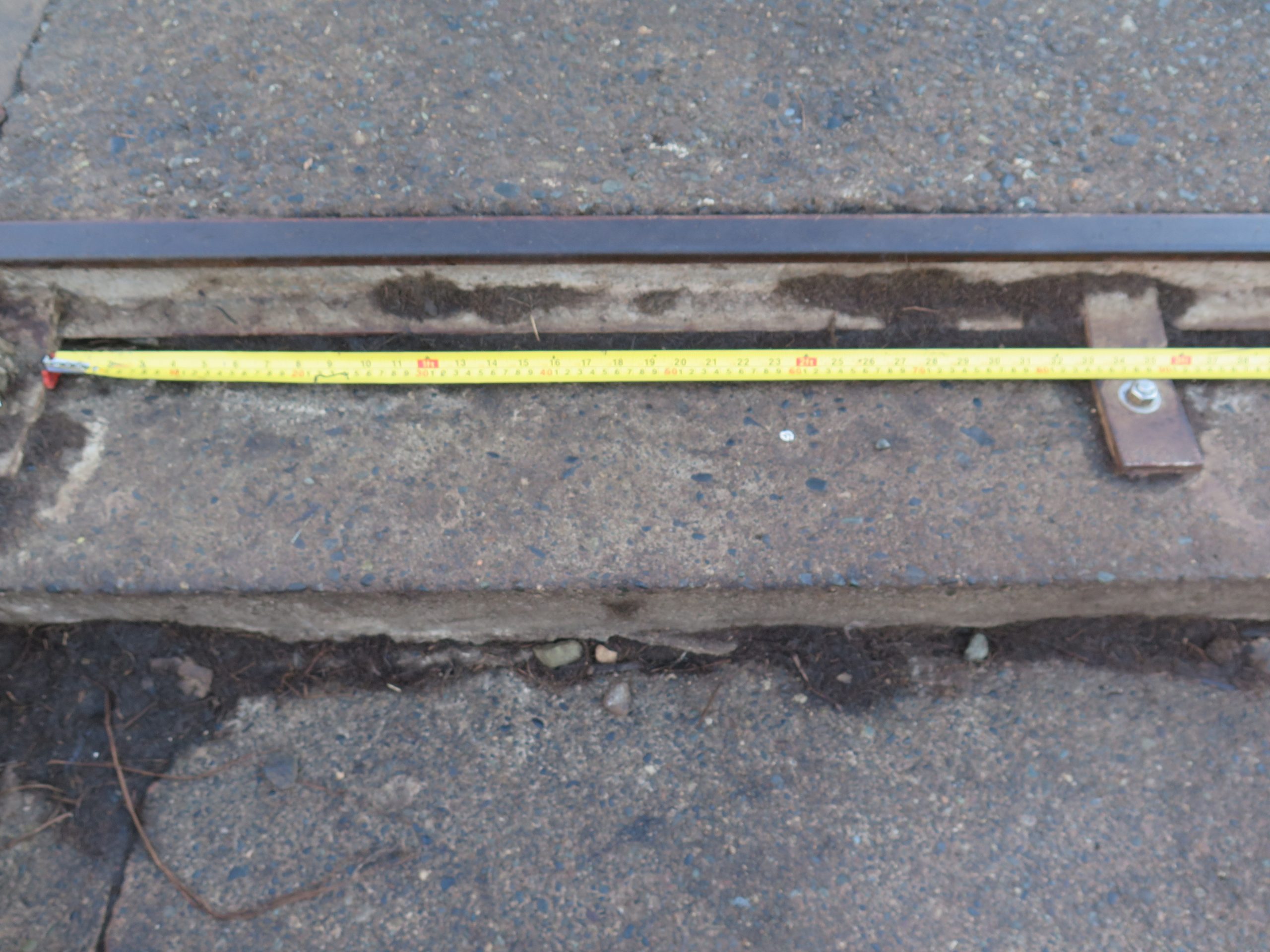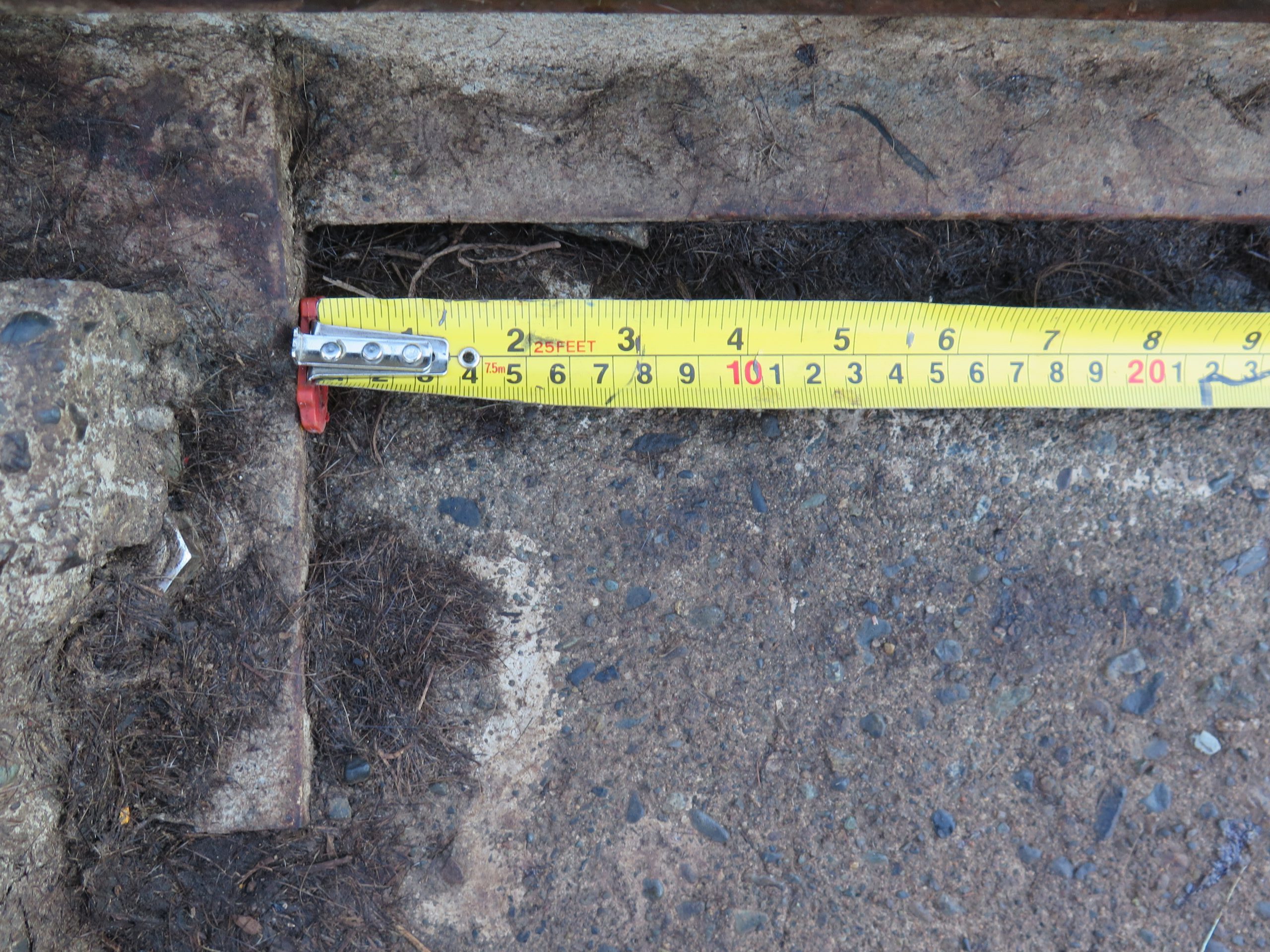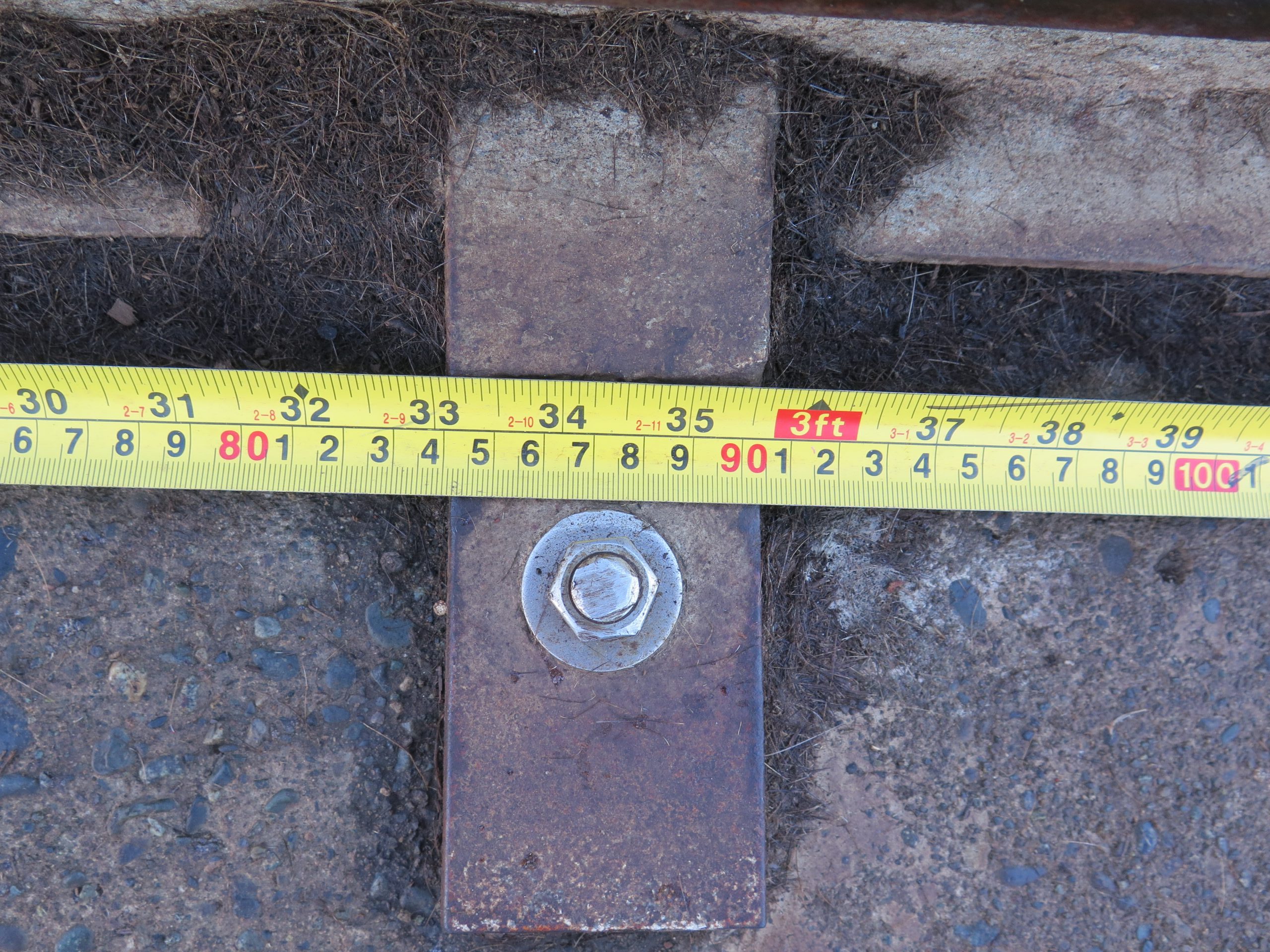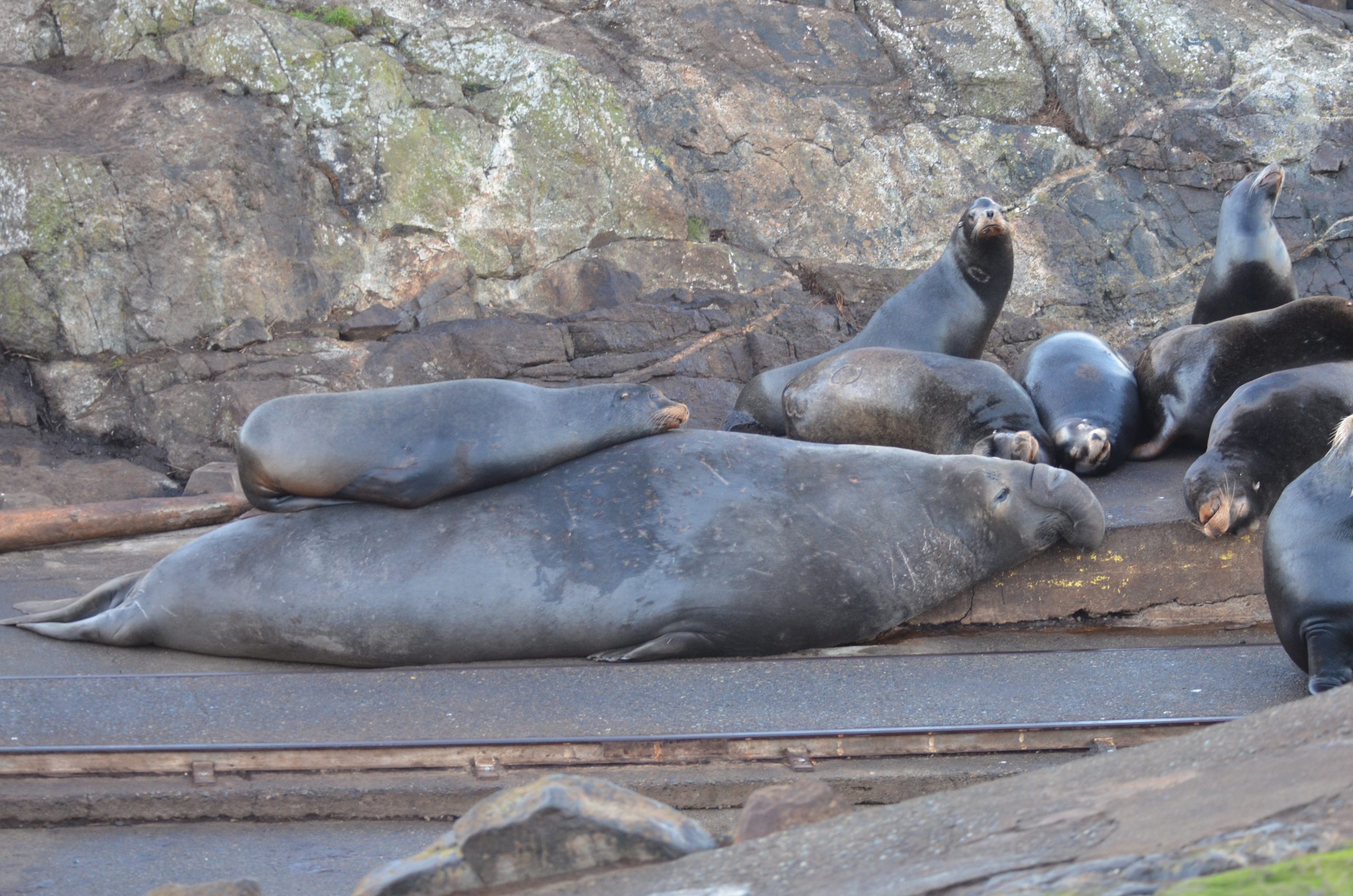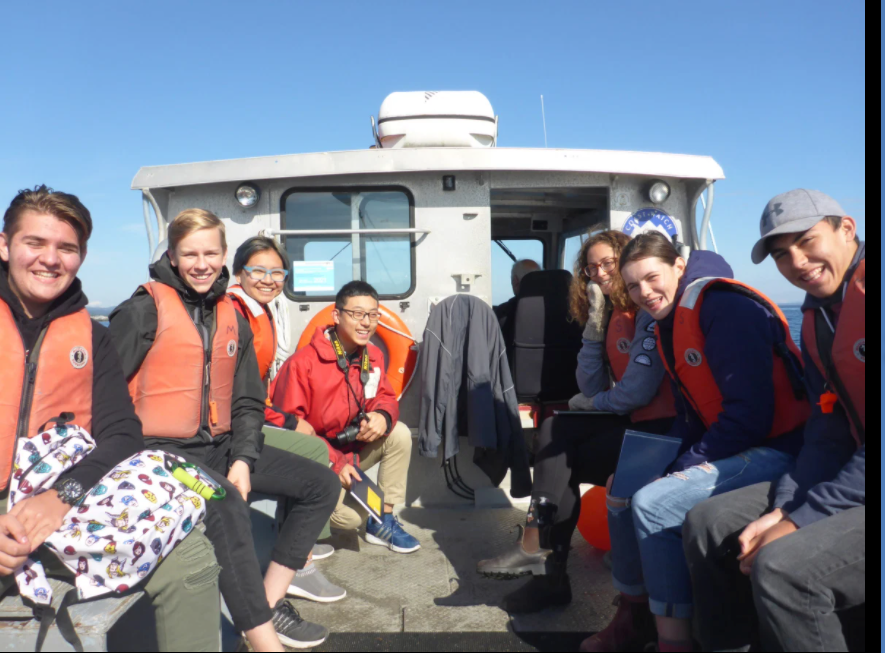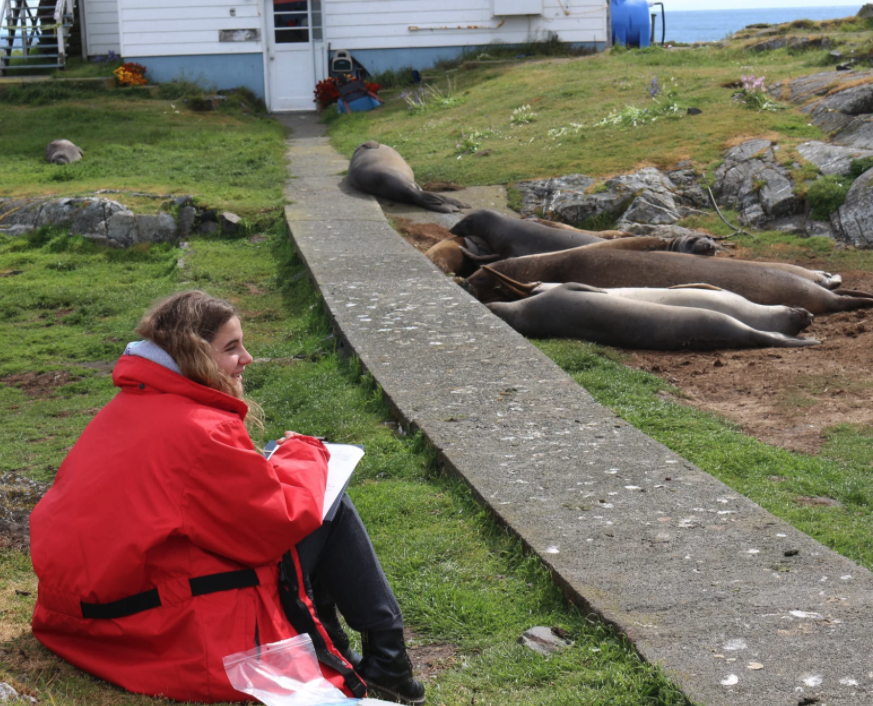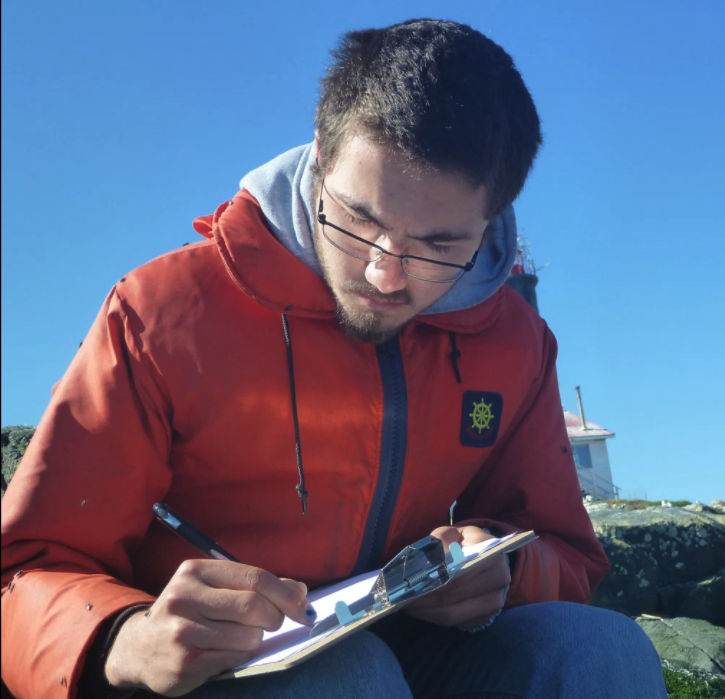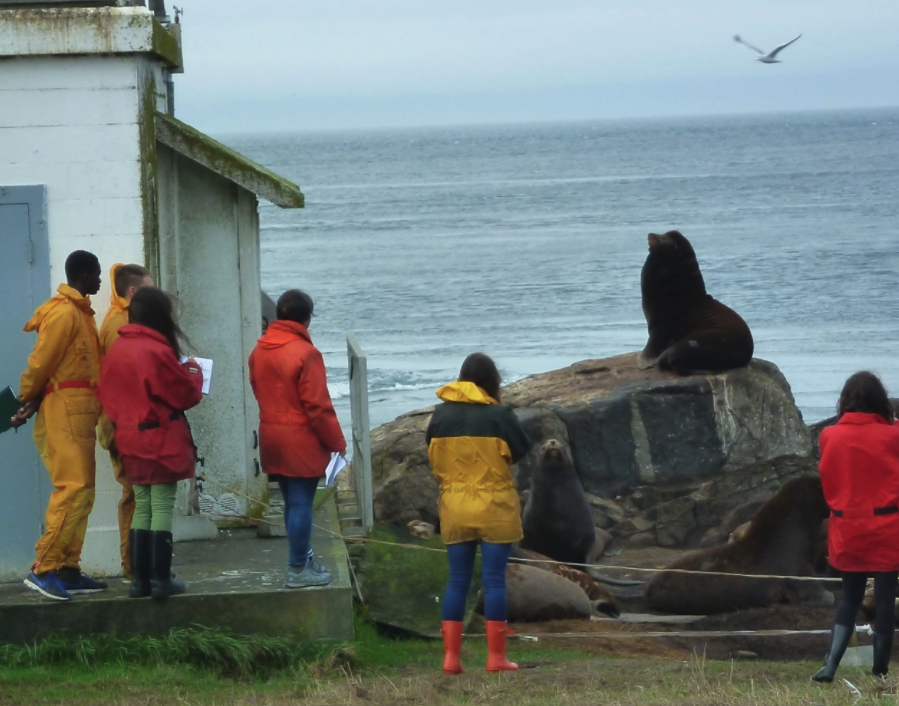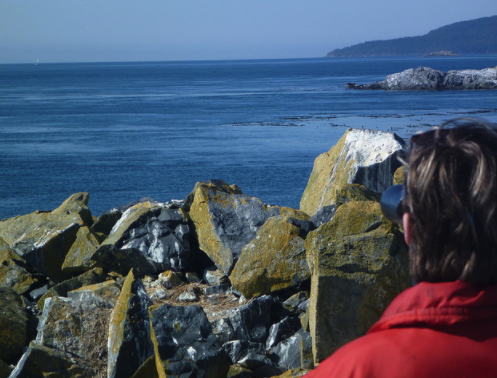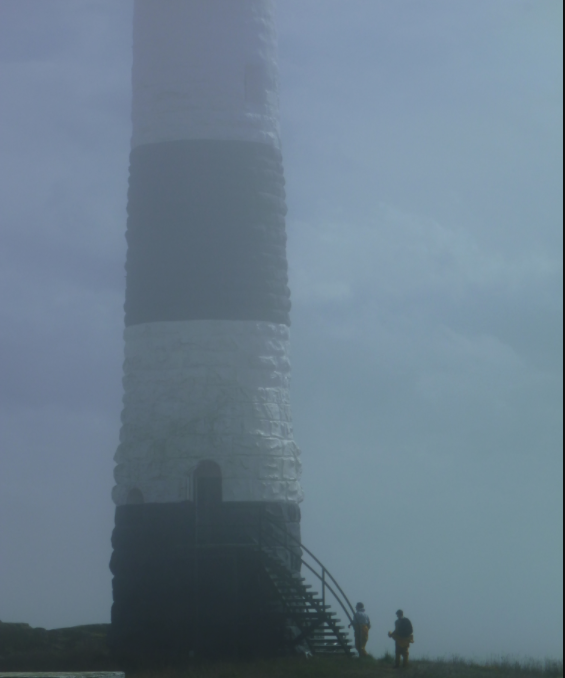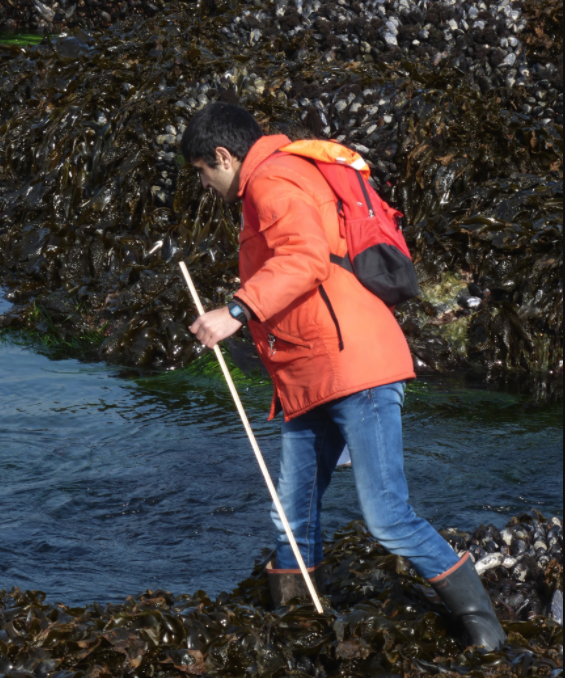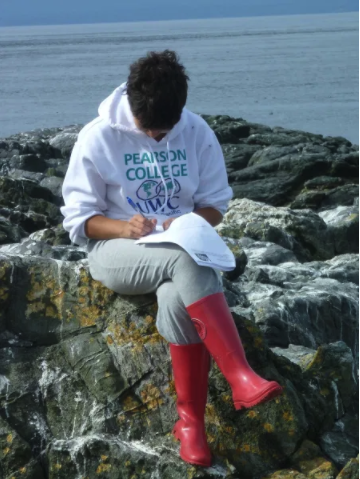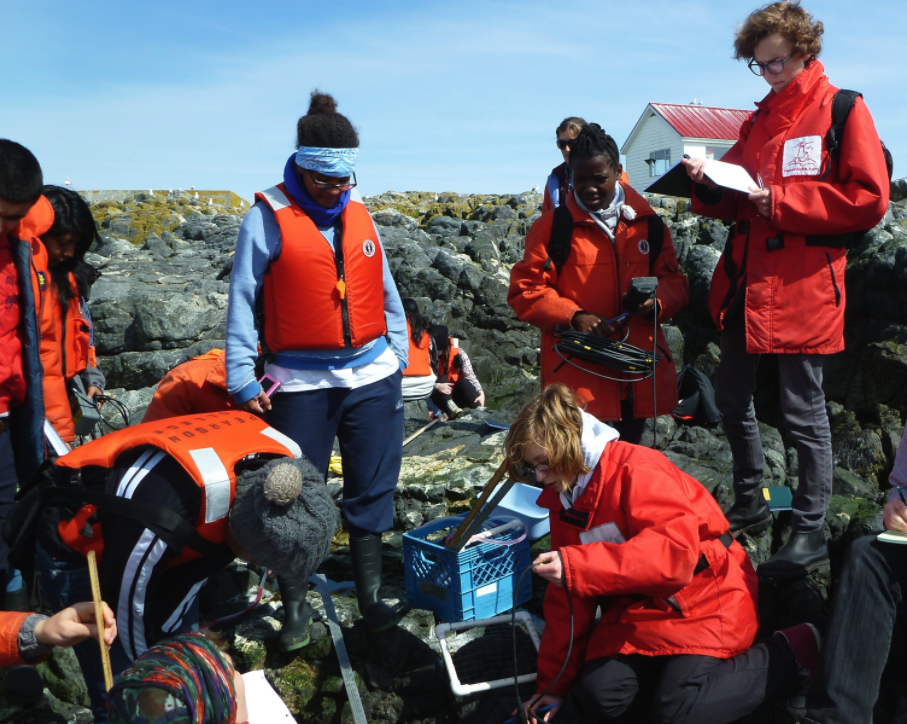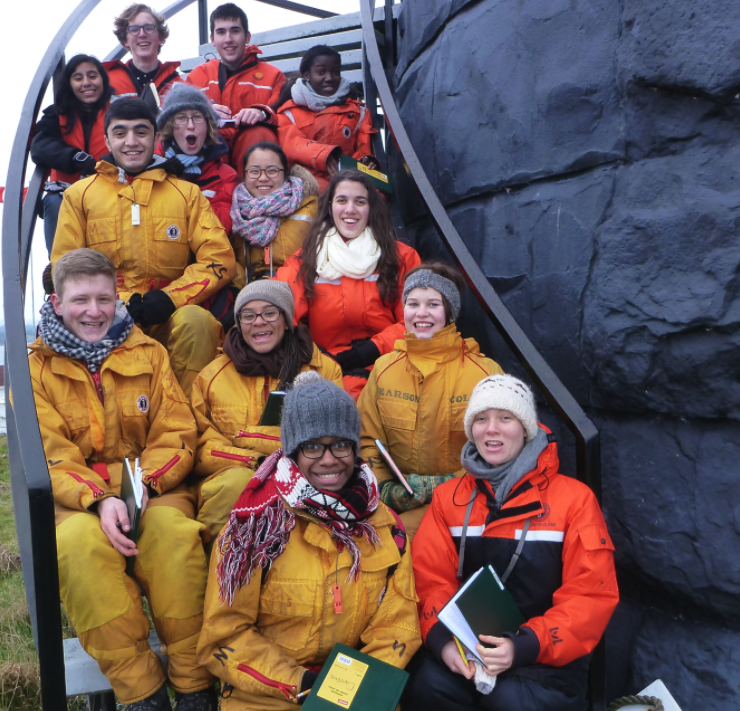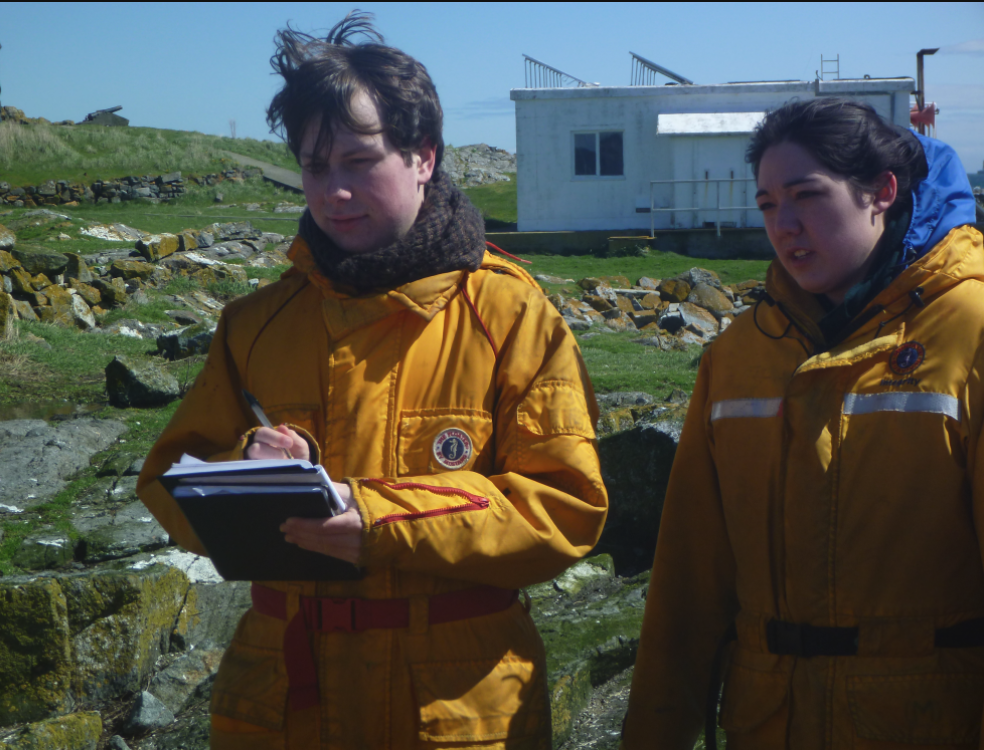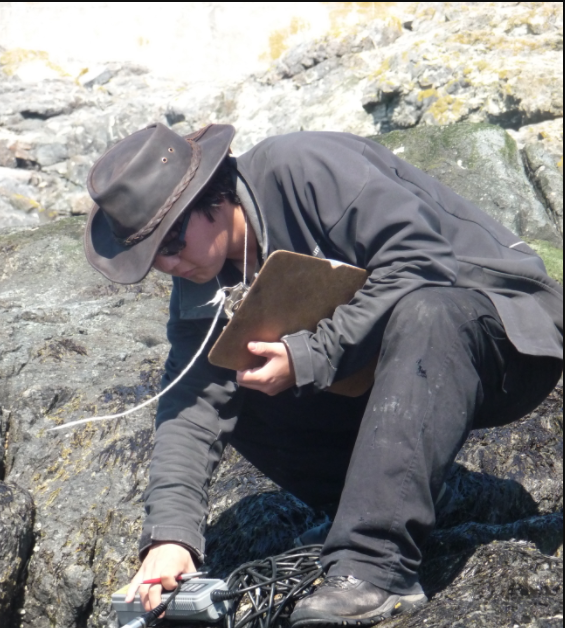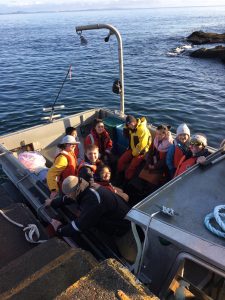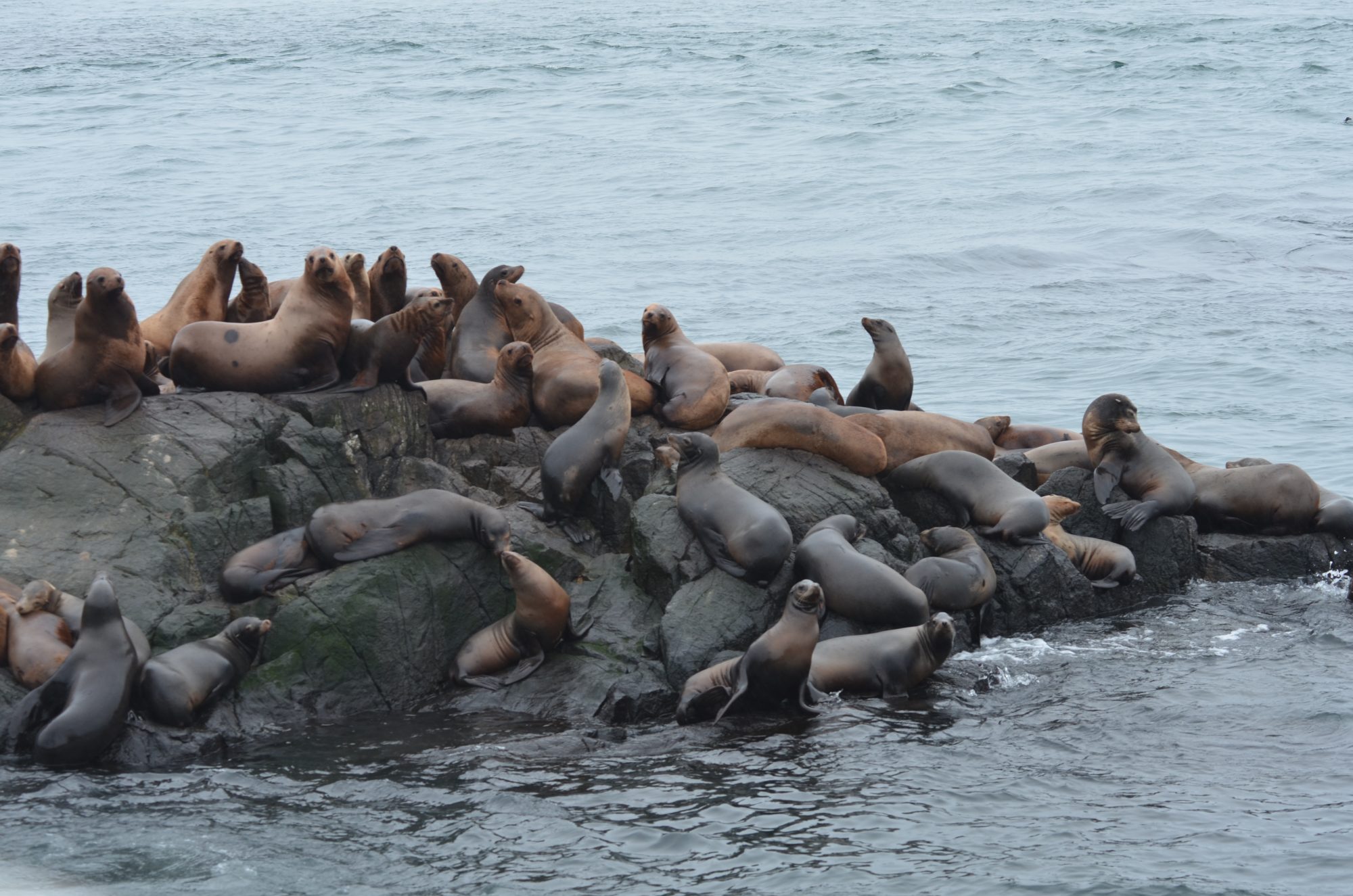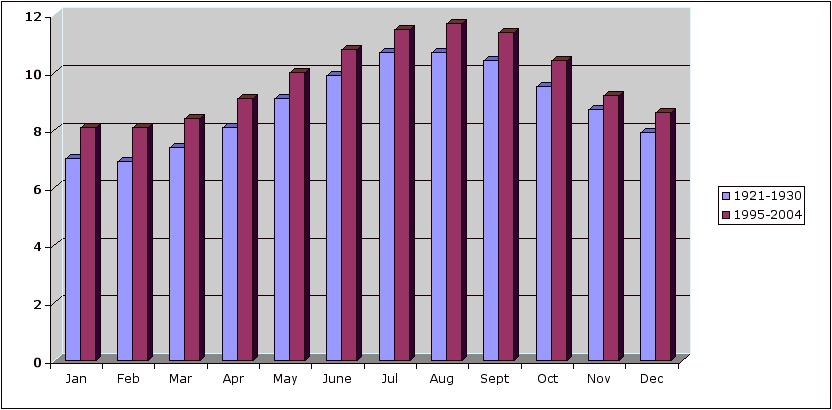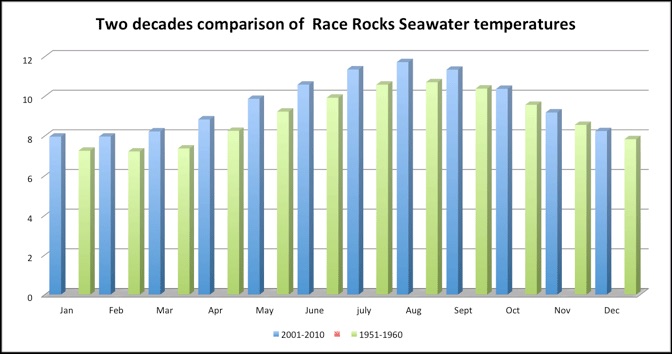THE 13 MOONS of the WSANEC (Saanich people)- Now a JASON PROJECT Curriculum Lesson:Teacher Instructions
To order books contact :
Saanich Indian School Board,
7449 W.Saanich Road,
P.O. Box 368, Brentwood Bay, B.C.
V0S 1A0
Telephone 250-652-2313
Note – accurate spelling of the names is available in the calendar,(top left below) These images have been scanned with permission from the booklet ” The Saanich Year” Author Earle Claxton, Author/Illustrator: John Elliott. Published by the Saanich School Board #63 1993 ISBN 1-55036-366-2
-

-
The Thirteen Moons Calendar
-
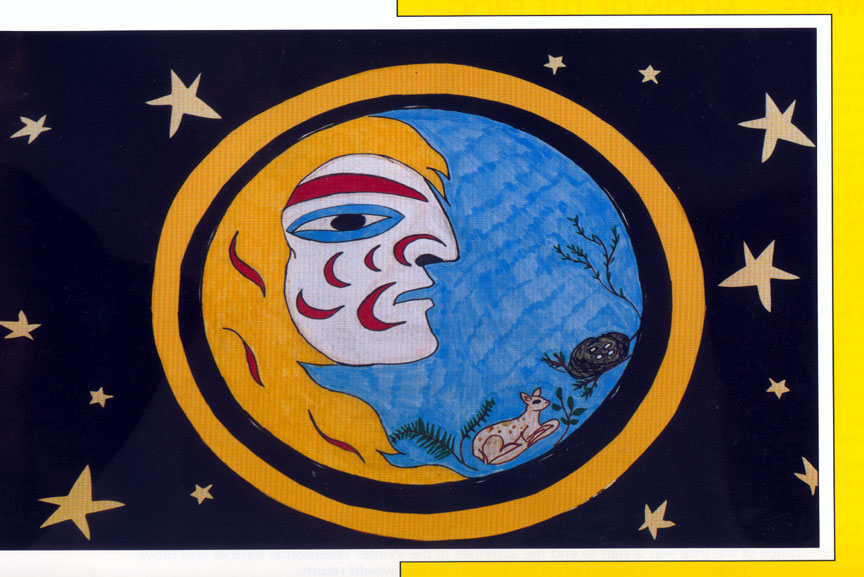
-
NINENE-Moon of the Child (Jan.)
-
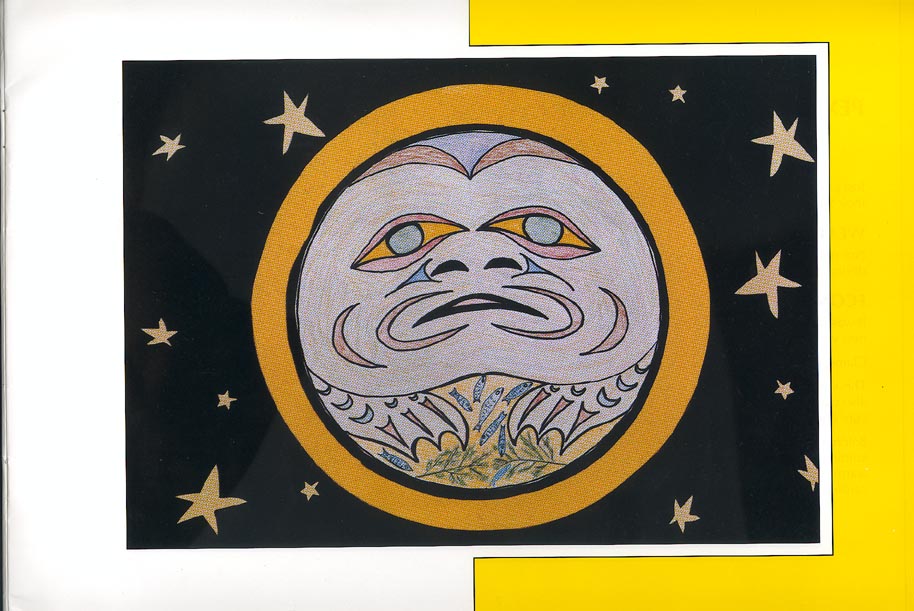
-
WEXWS-Moon of the Frog (Mid Feb. to Mid March)
-
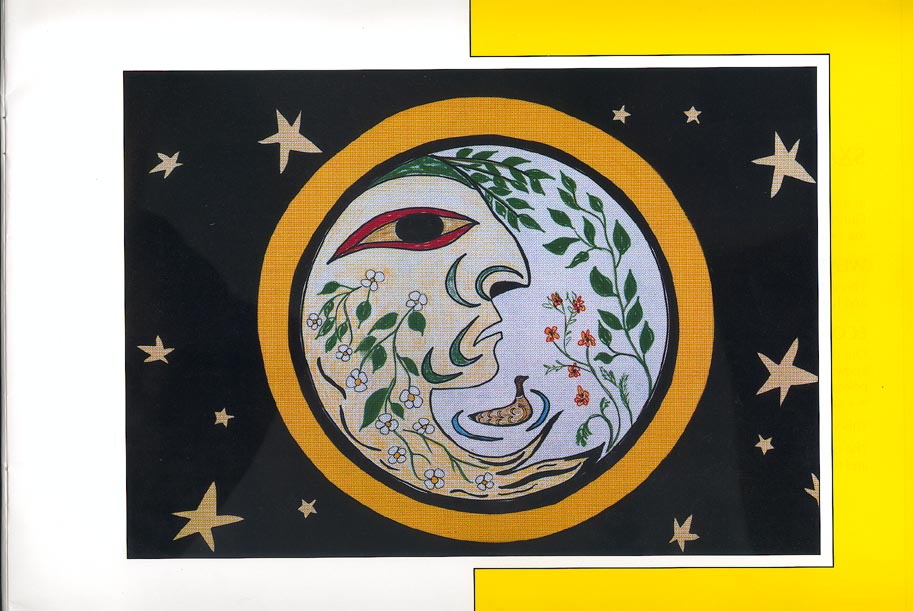
-
PEKSISEN-The Moon of the Opening hands the blossoming out Moon (Mid-March to Mid April)
-
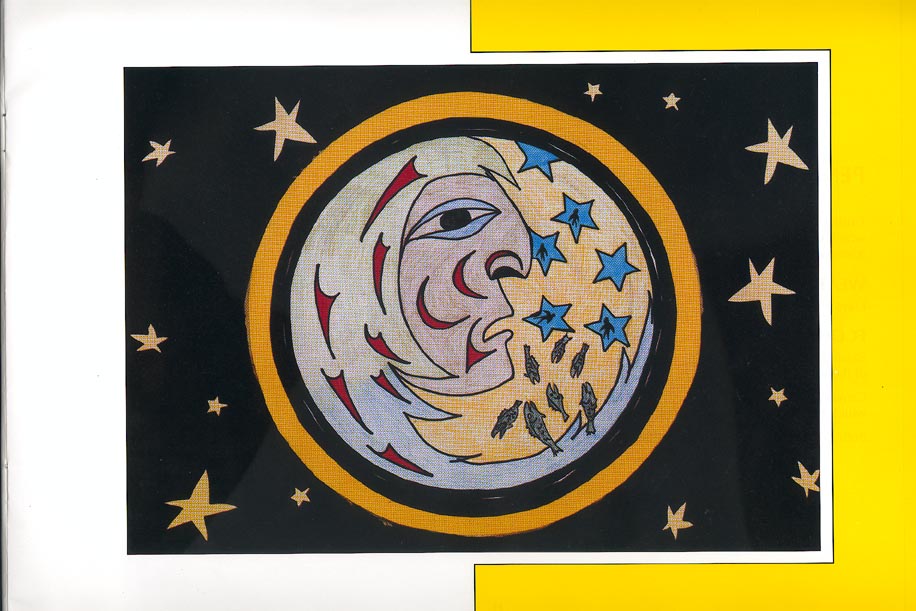
-
SXANEL- The Bullhead Moon (April-May)
-

-
PENAWEN-Moon of the Camas Harvest (May)
-
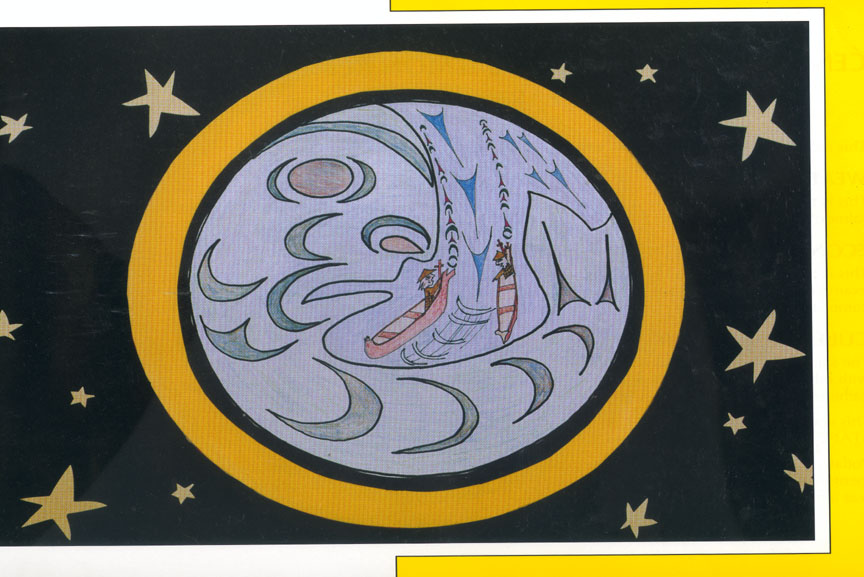
-
CENTEKI- The Sockeye moon (May-June)
-
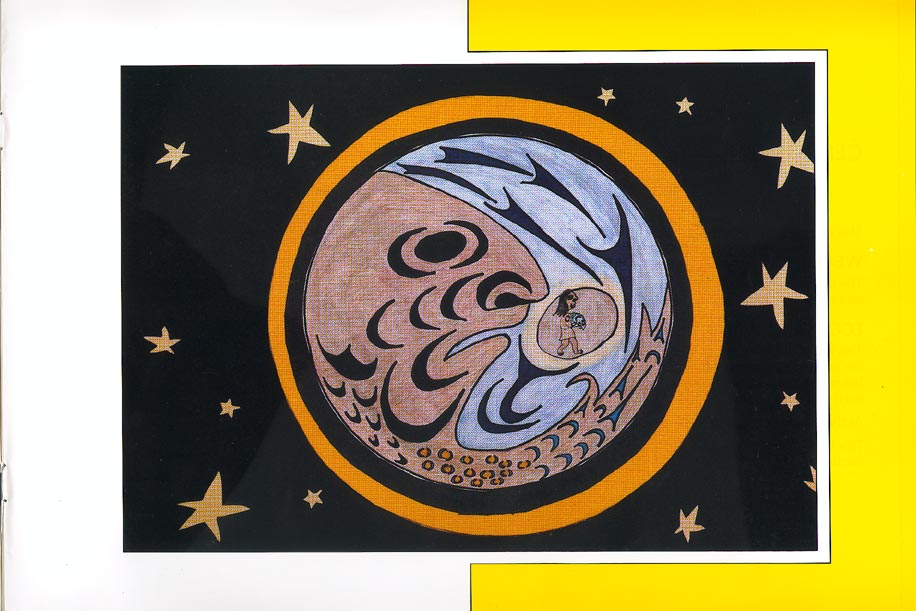
-
CENHENEN-Humpback salmon return to earth (June-July)
-
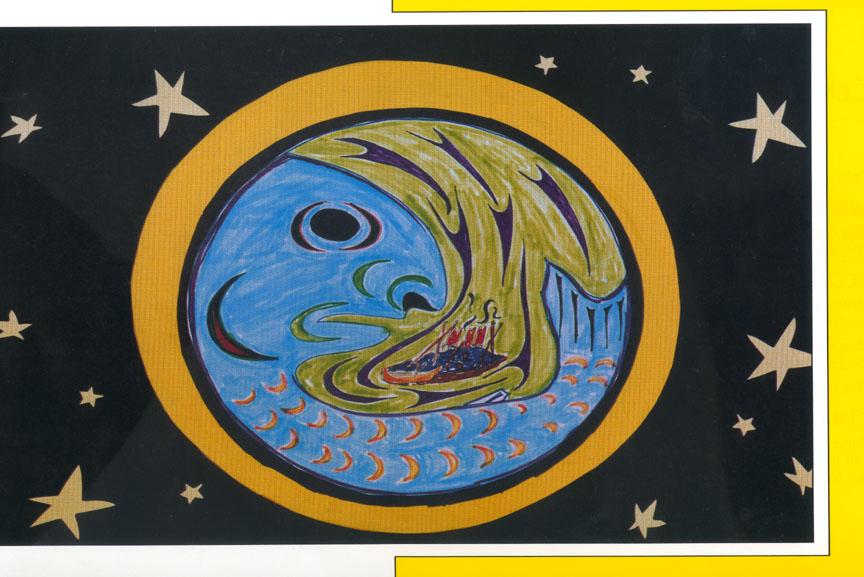
-
CENTAWEN- The Coho Salmon return to earth (August)
-

-
CENQOLEW-The Dog Salmon return to Earth ( Sept)
-
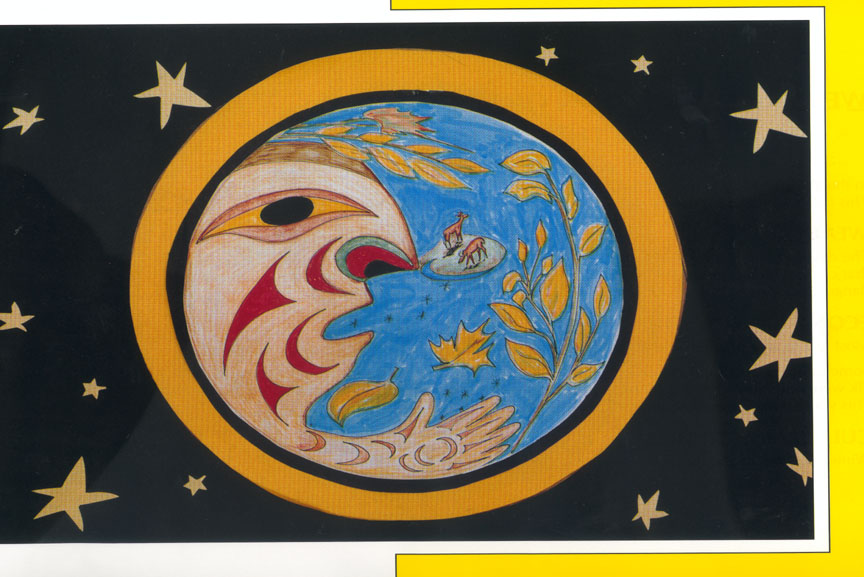
-
PEKELANEW-Moon that turns the leaves white(Oct.)
-
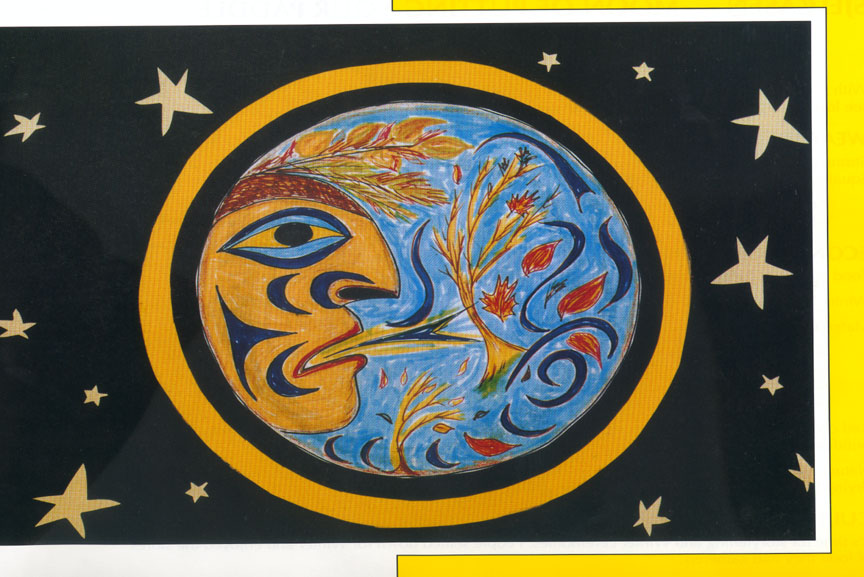
-
WESELANEW Moon of the shaker leaves -(Oct.-Nov.)
-
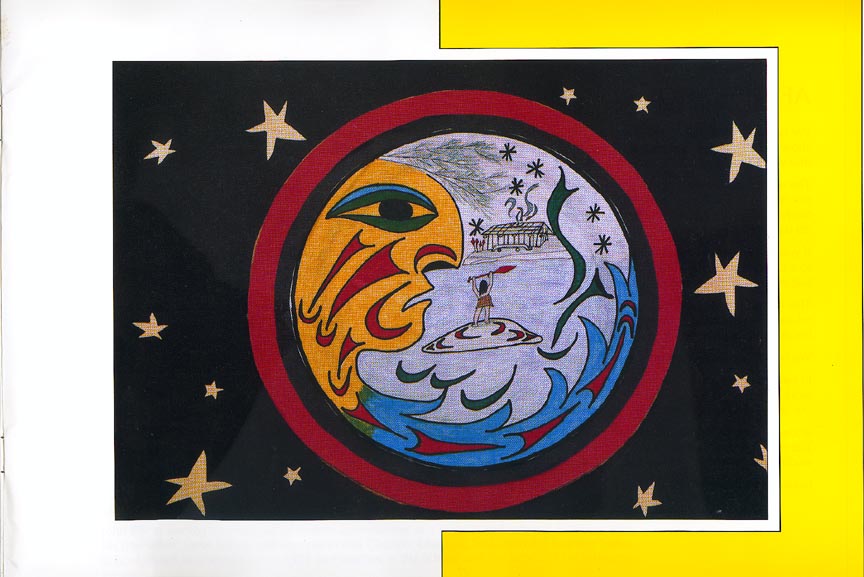
-
SJELCASEN- The Moon of putting your paddle away in the bush (Nov.-Dec.)
-
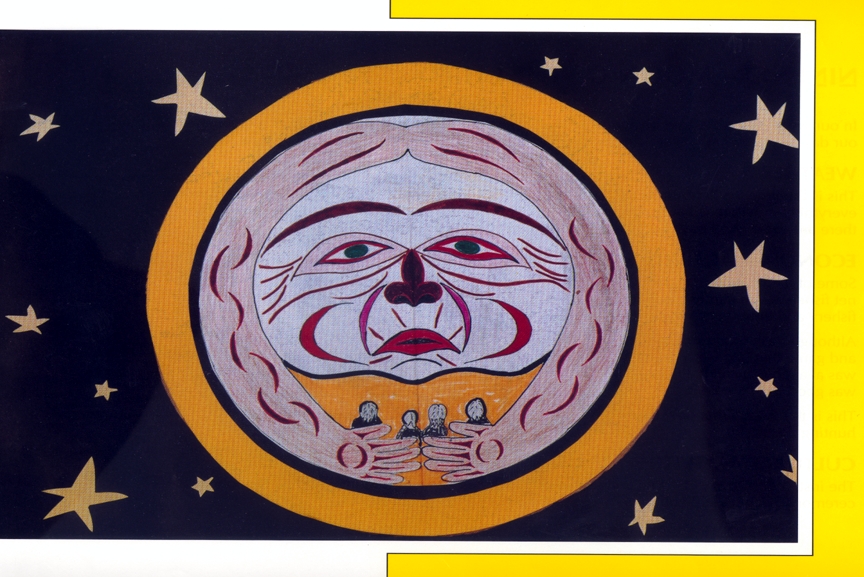
-
SIS,ET- The ELder Moon (Dec)
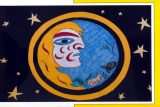
NINENE-Moon of the Child (Jan.)
NINENE – MOON OF THE CHILD (Mid December to Mid January)
The face of the young man represents youth, a new beginning, the rebirth of the animal world, and the new edible shoots. This is the Saanich New Year. The moon’s yellow hair is the returning light to the world.
CONNECTIONS AND BACKGROUND INFORMATION
The Winter Solstice (December 20/21) is the point at which the sun is farthest from the Equator, thus it is the darkest day of the year, and at this “turning point” the days will become longer. As with the Summer Solstice, the shortest day of the year holds great importance in many cultures.
WEATHER
This is the time that the Northern Hemisphere starts to move closer to the Sun once again. All things begin to warm up; everything in nature is being reborn. Although it is cold and there are Winter rains, there are some good days and this is the first sign that a new year has begun.
ECONOMIC ACTIVITIES
Some of the twine that had been made from nettles was now woven for reef net fishing. Each family group had a responsibility to produce a certain amount of net or the fishery and these parts would later be assembled. Because there was no hunting or fishing going on, people relied mainly on the fish and game that had been stored for the Winter. For those who would risk the rough seas, there was halibut fishing as the fish returned to their spawning grounds. This was also the season when fawns were born, so the new moon signaled the time to stop deer hunting.
CULTURAL ACTIVITIES
The instruction of the children through telling of tales helped to pass the long Winter nights. The longhouse ceremonial dances continued.
THINGS TO THINK ABOUT
Why do so many cultures celebrate New Year’s at this time of year?
What are New Year’s celebrations like in other cultures?
Are other culture’s New Year’s celebrations in and around the winter solstice?
If you were to develop your own New Year’s celebration, how would you organize it?
=================================================
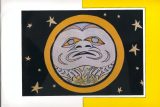
WEXWS-Moon of the Frog (Mid Feb. to Mid March)
WEXES – MOON OF THE FROG (Mid February to Mid March)
The frog on the face of the moon represents DOLUANW – the Keeper of the Sacred Season. It is time to gather foods and medicine. The Saanich People place cedar boughs in the water close to the shore, so that the herring will lay roe on them.
CONNECTIONS AND BACKGROUND INFORMATION
February derives its name from the Latin word ‘februarius’ which means to purify. The Saanich People, like the Romans, designated this month to sacredness and purification. March derives its name from Mars, the Roman god of War. The Anglo Saxons called it the ‘Hlyd Monath – the loud and stormy month’.
For the Saanich Peoples, this moon in particular was significant because the frog acts as a witness and a messenger to them. The frog announced the Sacred Season of Plenty. Because the frog was honoured as the Keeper of the Sacred Season, it was often presented on totem poles and in artwork to show that an important event had occurred.
During this moon, the wonder of nature repeats an amazing process: Mother Earth warms up and the hibernating frog wakes from its winter sleep, announcing the coming of spring.
WEATHER
As the Northern Hemisphere moves closer to the Sun, the more the Earth warms. Rains diminish and more sunshine is evident.
ECONOMIC ACTIVITIES
This moon was especially welcomed because it signalled that the ocean had become safer to travel on and it was time to put the canoes back into the water. Herring and herring roe, a source of food, were collected by placing cedar branches along the shore for the herring to lay their eggs upon. Herring was also dried into a delicacy called QELEJ and stored for future use. The earliest runs of herring were into Fulford Harbour on Saltspring Island.
CULTURAL ACTIVITIES
The appearance of the frog was a sign to end the activities of Winter ceremonial dances and move outdoors to prepare for the season when the Salmon people would return.
THINGS TO THINK ABOUT
- Who or what do you honour in your life?
- What signals does nature give us to start or end things?
- In what ways do you and your family prepare for spring?
==============================================
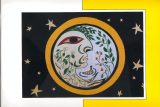
PEKSISEN-The Moon of the Opening hands the blossoming out Moon (Mid-March to Mid April)
PEXSISEN – THE MOON OF OPENING HANDS THE BLOSSOMING OUT MOON (Mid March to Mid April)
All the plants and trees are opening up their hands again and the moon meets their welcome. All of nature is blooming. At this time the Brant Geese are dried. The Earth renews its strength.
CONNECTIONS AND BACKGROUND INFORMATION
April derives it name from the Latin word “Aprilis”, the Roman goddess Aphrodite and the Greek word “to open”. It should be noted that most countries in the Northern Hemisphere celebrate the arrival of Spring. At this time of year, the trees open their leaves in welcome, just as the Saanich People open their hands to show thanks.
WEATHER
There is less rain than previous months and it is warmer. This helps dry out the land and enables the drying and preservation of food.
ECONOMIC ACTIVITIES
During this time, the Saanich Peoples hunted and dried XELXELJ (Brant Geese) for future use. Float nets were placed where the XELXELJ would feed along the tide line to capture the geese. Clams, Oysters and mussels were at their best that this time of year, too.
Cedar trees were fallen at this time of year to make boats, among other things. The warmer weather also caused the tree sap to run up the trees, making it easier to strip the bark. The fallen trees were then left to cure and the bark was saved for weaving into mats and clothing.
Before the Saanich People started to raise sheep, they would use goat and dog hair for spinning yarn and knitting. Their primary wool source was a breed of dog that was small, white and woolly. The warmer weather caused the dogs to shed and their hair would be gathered for carding and later, knitting.
THINGS TO THINK ABOUT
- What animal hair or wool is used in other countries? (e.g. Llamas)
- What activities happen in Western culture’s Gregorian calendar that are similar to those in the First Nations?
===========================================
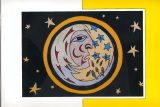
SXANEL- The Bullhead Moon (April-May)
SXÁNEL – BULLHEAD MOON (April – May)
This moon represents the visibility of SXÁNEL or what westerners call Orion’s Belt. The moon’s hair represents a strong wind that comes at this time and the swallows that arrive with the wind.
CONNECTIONS AND BACKGROUND INFORMATION
In this moon, the PIOTEL (a group of three starts in Orion’s belt called the Duck Hunters) appears on the horizon. During the SXÁNEL there are strong winds, the bullhead (a type of sculpin) appear on the shore and the swallows arrive.
WEATHER
This is the season where good weather is the norm. However, these days can bring sudden thunder and lightning storms.
ECONOMIC ACTIVITIES
People spent more time on and around the water. During the moon the Elder women knew how to take their baskets to the beach and gather bullheads from under the rocks. The women would pole sticks under the rocks and big bullheads would say “SKA”, which is their name. The bullhead was deemed a great delicacy.
This was also a great time for harvesting seaweed LEKES).
The halibut fishery ended because the halibut spawned during this moon. The grouse hatched and the larger/older grouse could easily be snared in the woods.
THINGS TO THINK ABOUT
- What are activities that you start participating in now that spring has arrived? Compare these to First Nations’ activities.
- What do you look forward to during this season?
- What is a delicacy or a delectable? What foods do you consider to be delicacies or delectable?
- What do you eat that comes from the sea?
===============================================
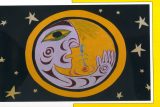 PENAWEN-Moon of the Camas Harvest (May) PENAWEN – MOON OF THE CAMAS HARVEST (May)
This moon is the moon of the camas harvest. It is time to dig KLO,EL (camas). The earth is warming. The camas bulb illustration is shown on the cheek of the moon and in the palm of his hand. The blue plant with the bulb underneath the ground is the whole camas plant.
CONNECTIONS AND BACKGROUND INFORMATION
May derives its name from Majores, the Roman goddess of Spring. This is also the ‘month of Mary’ for those of the Roman Catholic Faith. During the PEN’AWEN moon the Saanich Peoples travelled to family locations to harvest camas bulbs (KLO,EL), which were the source of starch in their diet. This was a cherished time for the people of Saanich – it marked the time when they could begin travelling through their territory again.
WEATHER
Days are evenings are warm and rain is less frequent.
ECONOMIC ACTIVITIES
Saanich families had traditional territorial grounds (land and water), which were used at various times of the year. Most families left their Winter villages for Spring camps. Visits to the camas plots served two purposes: (1) to harvest the blue camas bulb; and (2) to gather the fresh gull eggs found in the camas fields. White camas is poisonous and was not harvested.
In this season both XIWE (purple sea urchins) and SQITI (green sea urchins) were collected and eaten as well.
THINGS TO THINK ABOUT
- Since this is a time of travel, what would you take with you on a camping trip?
- What cultures and animals still migrate seasonally? Compare and contrast modern migration due to job loss, over-crowded population centres and health problems.
================================================
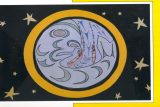 CENTEKI- The Sockeye moon (May-June) CENTEKI – THE SOCKEYE MOON (June)
This moon is the same colour as the pale grey sockeye salmon. The sockeye returns during this moon. The Salish art design represents the tide running swiftly through the reef net which is tied to the two canoes (SXELSCET).
CONNECTIONS AND BACKGROUND INFORMATION
There are two western legends to how this moon was named. First, is that it derives its name from the Roman goddess of woman and marriage (Juno) and second, that the name is derived from Juniores, the name for the lower branch of the Roman senate and/or connected with the Roman consulate, Junius Brutus. It is interesting to note that June is in mnay cultures, the wedding month, and there are festivals of flowers around the world.
The Saanich Peoples history says that the people were once very poor. However, the Salmon people took pity on them and saved them by showing them how to fish and honour the salmon. At the beginning of the CENTEKI moon, a special salmon ceremony was performed before the net anchors were dropped at the ancestors hereditary family locations. The special ceremony started when the medicine man (SNAEM) paddled to the furthest point east and called on ancient relatives (the salmon) to let themselves be caught to feed the WSANEC people. His songs and prayers mentioned all of the family reef net locations that the salmon would pass through. Fishing continued throughout the four salmon months.
WEATHER
Warm summer breezes and dry weather were most evident during the CENTEKI season. The WEWELES (Swansen’s Thrush) – the ripener of the summer berries, arrived. His song put colour into the berries. The DILEK (wild strawberries) and ELI,LE (salmon berries) began to ripen.
ECONOMIC ACTIVITIES
Trading catches from the salmon runs began. As the Saanich Peoples were the first to catch salmon in the Straits because other tribes were waiting for river runs, they were able to catch a higher quality of bright salmon, thus giving them a full month of trading advantage.
CULTURAL ACTIVITIES
The Saanich People paid homage to the salmon with a very special song and ceremony to honour the salmon and show respect to its new generation. After the first sockeye salmon (known as the S,HIWEK leader) was caught, all fishing would cease and the ceremony of prayer and feast would begin. As part of the salmon ceremony, children would walk with a limp to show humbleness and to look pitiful in the eyes of the honoured salmon. They would also carry the hook nose salmon as one would carry a baby. Only the children would eat this salmon. Later, the adults could then feast on the Sockeye.
THINGS TO THINK ABOUT
- Japan also honours its children with a special day. Why would cultures honour children?
- What other age group is honoured during the Saanich moons?
- Can you create your own ceremony to celebrate something in your life?
|
=============================================
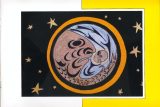
CENHENEN-Humpback salmon return to earth (June-July)
CENHENEN – HUMPBACK SALMON RETURN TO EARTH (July)
The Humpback salmon return to the earth during this moon. The illustration is half salmon and half human. The darts show the tidal waters that are used to catch salmon. The child carrying the salmon represents the first salmon ceremony in honour of the salmon. Saanich People humble themselves to the salmon.
CONNECTIONS AND BACKGROUND INFORMATION
July derives its name from Julius Caesar, who was born during this month. This month is important in Spain (bull fights) and Japan (animal festivals). Actual jousting and other medieval-type activities take place for three days during the Japanese Horse festival.
This moon marks the arrival of the Humpback salmon.
WEATHER
This was the dry weather season, drier than the interior of Canada. Although it was a good season for drying Salmon (SDÁL), the grass and forest was parched and everyone guarded against starting grass and bush fires.
ECONOMIC ACTIVITIES
This was the season for Humpback salmon fishing. Fishing caused First Nations peoples to extend catchment areas to areas as far away as Tsawassen and Point Roberts where they maintained shore camps.
CULTURAL ACTIVITIES
The success of the salmon fishery caused those most fortunate to celebrate and share their success with others. This season was especially marked by large family, village and neighbouring village gatherings, including gatherings where traditional sports were held. This was a time to reaffirm family ties and history and hold other gatherings. These included STÁNEK (memorial potlatches), namings (giving of a name ceremonies), weddings and societal ceremonies (e.g. blessings).
Potlaches enabled the more fortunate to share and distribute goods with those less fortunate than themselves. To become wealthy was honourable and to share one’s wealth with one’s neighbours was a traditional expression of Saanich values.
THINGS TO THINK ABOUT
- What sports events are held by first Nations People are similar or different to those found in other communities and countries?
- What does being wealthy mean to you?
- In what ways can an individual, community or country be wealthy?
- Does wealth always have a connection with careers and money?
- What is the difference between work and play?
- Can they be synonomous?
- What are the values of your family? How are values, beliefs and achievements celebrated?
==============================================
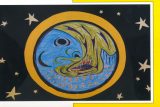
CENTAWEN- The Coho Salmon return to earth (August)
CENTÁWEN – THE COHO SALMON RETURN TO EARTH (August)
The Coho Salmon returns to the Earth. The illustration shows the face of the Coho and the human together. The face of the Coho/human is to remind the Saanich Peoples that the salmon were human at one time. The swift running tide picture illustrates where the salmon travel. The camp is the home away from permanent home for the Saanich Peoples.
CONNECTIONS AND BACKGROUND INFORMATION
August derives its name from the Roman Emperor Augustus Caesar. In most northern countries this is the time for summer holidays, fairs, fetes and festivals. The moon marks the arrival of the Coho Salmon.
WEATHER
The first rains begin and break the drought of the summer. Water flow in the streams, rivers and creeks increases. This enables the salmon that have gathered in the inlets, to begin their spawning journey.
ECONOMIC ACTIVITIES
This was a good moon for cod fishing. Traditionally the sea urchins were used as bait for Tommy Cod and the Tommy Cod was used as bait for the larger Ling Cod. Ling Cod could be lured to the surface with bait alone and speared since they were so anxious to protect their nests, that they would take a hook without the bait. As the weather cooled, the rains came and the forest was renewed once again. Deer Hunting began. This was also a good month to harvest the Hog Fennel (KEXMIN) which was used in a variety of First Nations medicines.
THINGS TO THINK ABOUT
- What are differences between Coho, Sockeye, Humpback and Dog Salmon?
- How can you tell if a fish is fresh or not?
- This is a time for harvesting plants for medicines. Can you think of any plants that produce medicines?
==========================================
|
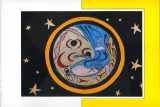 CENQOLEW-The Dog Salmon return to Earth ( Sept) CENQOLEW – THE DOG SALMON RETURN TO EARTH (September)
The Dog Salmon return to the Earth Moon at this time. The colours are Dog Salmon (ochre red). The men are returning the bones of the salmon to the sea, with thanks, in the belief that the bones will come to life and replenish the salmon stocks. The man raises his oar to show honour and respect to our relative, the salmon, who helps us survive.
CONNECTIONS AND BACKGROUND INFORMATION
September derives its name from the Latin word ‘septem’, meaning seven. This was the seventh month in the Roman calendar when the year began in March. This moon marks the arrival of the Dog Salmon.
WEATHER
The rainy weather continues and the winds have become unpredicatable. The creeks and rivers rise enough for the Dog Salmon to spawn.
ECONOMIC ACTIVITIES
Hunting for deer and groups was still ongoing. This was also the best season and weather conditions for cod fishing. Dog Salmon were the last of the salmon runs to return and the Saanich Peoples carried out this fishery at Goldstream. Dog Salmon was easily dried or smoked and was the last of the preserves to be stored away. The Langford area was excellent for cranberries, blueberries and grouse hunting.
CULTURAL ACTIVITIES
If the salmon run was late, the SNAM (spiritual leader or priest) was brought in to hold a ceremony to call the salmon. The SNAM would also advise the family captains of the correct protocol to adopt so that they would not offend the Salmon Peoples and thus ensure that the salmon returned to the rivers.
THINGS TO THINK ABOUT
- This is a time for preserving foods. Do you preserve or can any foods in your family?
- What Fall celebrations do other cultures celebrate?
- The Saanich People give their salmon bones back to the sea in thanks. How do you give thanks in the fall?
- With reference to the water cycle and personal observations of rivers and creeks, discuss the effects of rising water levels in creeks and rivers on communities.
- If possible, go to a local river, like Goldstream Park and see the Salmon spawning.
- What is the lifecycle of the salmon?
|
=============================================
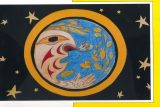
PEKELANEW-Moon that turns the leaves white(Oct.)
PEKELANEW – The Moon That Turns the Leaves White (October)
This is the moon of the turning white season (frost). This moon brings the first frost. The leaves lose their colours and turn pale. Deer hunting is the activity during this moon. The earth is cooling down and the people turn their efforts to hunting.
CONNECTIONS AND BACKGROUND INFORMATION
October derives its name from the Latin word ‘octo’ meaning eight. It was the eighth month of the Roman year. The moon marks the end of summer (snails) and the beginning of cooler weather.
WEATHER
The longer, cooler nights can lead to frost on the leaves and the ground in higher country.
ECONOMIC ACTIVITIES
The WSANEC people began splitting the cedar logs they had felled in the Spring. The completion of the canoes was Winter work. They would rough out their canoes in the forest making them easier to carry and move them to the villages.
Seals and Sea Lions were hunted in the San Juan Islands. Cod fishing tapered off toward the end of this moon and grouse hunting ceased. Preparations were made for the Fall hunt of the deer and elk. Deer were in their rutting season and easily fooled because they were not as cautious as normal.
THINGS TO THINK ABOUT
- What does ‘rut’ mean and why would deer be more easily fooled?
- What are various methods of hunting seals and sea lions?
- How is or was steam used to make canoes and bent wooden boxes?
===========================================
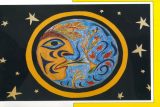
WESELANEW Moon of the shaker leaves -(Oct.-Nov.)
WESELÁNEW – MOON OF THE SHAKER LEAVES (November)
The leaves are ready to fall. The wind comes. Turbulence is felt in the waters and the skies. The earth is cooling down.
CONNECTIONS AND BACKGROUND INFORMATION
November derives its name from the Latin word ‘Novem’ meaning nine, and was the ninth moon in the Roman year. This marked the beginning of Winter. Traditionally, the Anglo Saxons did their slaughtering now (letting blood) because the cold weather was conducive to preserving the meat of the animal/bird. In the WESELÁNEW moon, fishing was undertaken mostly in the safety of local waters. This was the time when big winds come and changed the season to Winter.
WEATHER
The days became cooler and travelling in food gathering territory was limited. The winds that came with this moon were a signal to move to the winter village as the open sea became dangerous for movement in open boats.
ECONOMIC ACTIVITIES
Most foods were now in storage for the Winter and fishing was done only close to the village sites. The Saanich Peoples formed hunting parties and moved West into the mountains to hunt elk. Elk were only hunted after the first snowfall as it was easier to track an elk if it was wounded. This way no meat would be wasted.
CULTURAL ACTIVITIES
Winter fires were lit and this was the beginning of Winter gatherings.
THINGS TO THINK ABOUT
- What seasonal changes occur where you live?
- How does the direction of the wind affect climate?
- What are the effects of pollution and global warming on fish and wildlife?
============================================
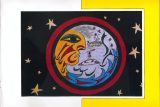
SJELCASEN- The Moon of putting your paddle away in the bush (Nov.-Dec.)
SJELCASEN – THE MOON OF PUTTING YOUR PADDLE AWAY IN THE BUSH (November).
This moon is the season of strong winds. The weather is unpredictable, making it unsafe to travel. It is time to put the big sea canoes and paddles away. It is time to honour the paddle for carrying one safely all season long. Snow is possible at this time of year. The long house activities start.
CONNECTIONS AND BACKGROUND INFORMATION
November derives its name from the Latin word ‘novem’ meaning ‘nine’. It was the nineth month of the Roman year. With the coming of this moon, it was time for the people to thank their paddle for taking them to gather foods, see loved ones and guide them to special ceremonies.
WEATHER
Strong and sudden winds are now common on the open sea and it has become unsafe to travel. Squalls and heavy rains can appear suddenly and without warning. South-easterlies are SKANET and south-westerlies are SCES.
ECONOMIC ACTIVITIES
Food gathering takes less time. The winter night tides were low enough for clam digging. Winter clothing was needed. There was now more time to weave mats and capes and to knit wool into clothing. Some items that were stored for Winter included:
- Materials for making twine, rope, lines, cables, baskets and storage boxes
- Cedar inner bark (SLEWI), cooking utensils, and cooking baskets
- Weaving materials for making baby cradles etc.
- Tools and fishing gear either made new or repaired.
Red cedar logs felled earlier in the year were now split into planks which were used as portable roofing and building material (S,ILETEW).
Natural splitting of logs was accomplished by inserting round stones as wedges into the cracks of the drying logs. The Winter winds hastened the drying and splitting process.
CULTURAL ACTIVITIES
It was a time for storytelling and Winter ceremonies. People settled down for Winter and enjoyed the food they had gathered and stored earlier.
THINGS TO THINK ABOUT
- Why do we need to ‘rest’ or putting the paddle away?
- Nature ‘renews’ itself through hibernation. Trees lower their production of sap in the winter. What are other ways that nature rests?
- How is the importance of the cedar tree in the Saanich Peoples’ culture similar or difference to the importance of plants in other cultures? (For example, think about corn!).
- Why is it so important to learn about our roots and heritage? Reflect on your own heritage. What has been passed down to you in terms of language, ideas, wisdom, artefacts etc. what is precious in your family? How does this relate to the stories and traditions of the longhouse?
================================================
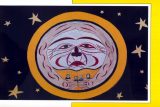
SIS,ET- The ELder Moon (Dec)
SIS,ET – THE ELDER MOON (December)
The Elder’s hair holds and shields the elderly people who share the teachings, the beliefs, the history and the culture with the children who are gathered in the warmth of the firelight.
CONNECTIONS AND BACKGROUND INFORMATION
This is the oldest of the moon family and means the elder. It is also the time when teaching occurs. In reality this is not the first month but the last in the yearly cycle of the moons. It is at this time of year when the earth is at its farthest point from the sun and the Winter Solstice occurs (December 20/21). As with the Summer Solstice, this day holds great importance in many cultures.
WEATHER
Days are short and storms and heavy rainfalls made sea travel unpredictable and unsafe. Therefore much more time was spent indoors. The sloughs in and around Saanich filled with water and provided a wintering place for visiting ducks and geese.
ECONOMIC ACTIVITIES
The Saanich people had abundant stored food and therefore had time to prepare for future harvests. Wood pitch was gathered for torches and fires. Torches were used to collect shellfish during the night tides, which were common at this time of year. Ducks and geese were netted or speared on the sloughs and in protected inlets. People only ventured into the protected inlets for ocean fishing. Nettles, gathered earlier in the year, were stripped and twisted into twine to make nets, ropes and cables. Roughed out canoes were brought into the longhouse to be finished.
CULTURAL ACTIVITIES
This is the most important time of the year for spiritual and cultural activities. The Saanich Peoples were involved in Winter ceremonies and the Elders told legends and stories to educate the children about the right way to live. The Saanich Peoples gathered in the longhouse for Winter ceremonial dances. New dancers were initiated and the dances witnessed.
THINGS TO THINK ABOUT
- What does the word ‘Elder’ mean to you?
- How does your society treat its elders?
- How might we learn from our elders?
- How does this picture depict teaching to you?
- What does the ‘right way to live’ mean to you?
- What celebrations does your culture have during Winter Solstice?
- How does your life change in the winter when there is less daylight and it is colder and raining or snowing, as compared to summer?

